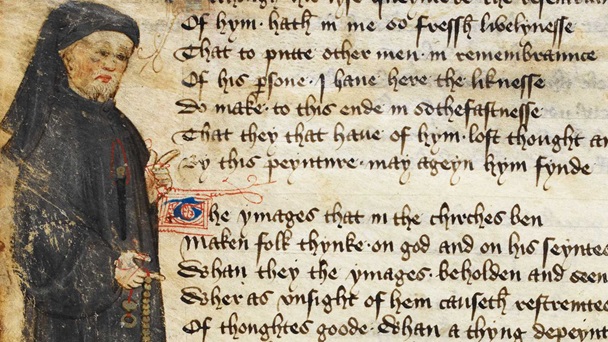Keats's Prologue to The Legend of Good Women I
by Eileen Foy
While studying in Aberystwyth, Wales – spending a term abroad during my master´s degree – I attended the module “Romantic Radical Cultures” that was taught by Professor Richard Marggraf Turley. This might come as a surprise as this is, of course, a blog about medieval stuff, which is also the main focus of my studies (especially medieval literature and in that particularly the Arthurian legends), but I decided to choose this module because I knew that some of the Romantic poets engaged with and adapted medieval authors. Thus, I thought that it would be interesting to see what they made of our medieval texts and how they engaged with them. Apart from that I thought that it would also be interesting to examine the themes we would discuss from a different perspective – contributing to it with my medieval background – as I had already engaged with various Old and Middle English texts and their subject matter, to which I could refer, and which might have served as an inspiration for the romantic poets.
In the second half of the term we studied the so-called Cockney School of Poetry and poets like Leigh Hunt, Barry Cornwall and John Keats who aimed at creating a poetry that is accessible to all people. To achieve this, they employed rather irregular rhyme schemes and made heavy use of stylistic devices like enjambment or slang as they thought that it mirrored the reality of everyday life far better.
Moreover, they had a strong interest in medieval literature. In their time, many adaptations of Boccaccio’s work, an Italian poet from the 14th century and author of The Decameron, were produced. The Cockneys were interested in the themes the Italian artist covered in his works and felt inspired to compose their own versions of Boccaccio’s poetry like for example Isabella, or the Pot of Basil by John Keats. It seems, however that none of them has ever adapted a medieval English text.
This made me very curious as I knew that they were definitely interested in medieval English literature: many of them admired Chaucer as becomes clear in Leigh Hunt´s Preface to The Story of Rimini and in several of Keats´s letters. From these documents it becomes clear that they were convinced that Chaucer had the same mission as they did: by making the deliberate decision to write in English, Chaucer created poetry that was more accessible to the “common” people. Furthermore, they adored his use of the English language – a purer, less artificial language; something they also strived for. The Cockneys, but especially Keats, clearly shared some common interests with Chaucer. Both Chaucer and Keats loved engaging with the “olde bokes” (The Parliament of Fowls, l. 24) and tried to include the old sources into their own poetry by adding their own ideas as both poets provide us with insights into the emotional life of the gods and goddesses from classical antiquity. Moreover, both adapted Boccaccio in their works and composed some of their poetic pieces in the genre of the dream vision. The most important thing they share, however, is their interest in the English language: To me it seems that they both understood that language is power as both made an attempt to democratise language and poetry maybe already visualising its potential for change.
Considering all of this, I was surprised to find out that Keats never adapted any of Chaucer´s works. Therefore, I chose the creative response for my assessment and composed an adaptation of the Prologue to The Legend of Good Women by Chaucer as it might have looked like if Keats would have written it. I chose this text as I felt like the dream narrator in the Prologue and the persona of Keats – both his real persona and the persona he creates in his poetry – show some similarities: both seem to behave socially awkward sometimes.
So, how did I approach adapting Chaucer’s Prologue while mirroring Keats´s style but also keeping myself in the work? In this endeavour, firstly, I tried to apply the poetic devices explored and heavily used by Keats (also scroll back to Cockney School of Poetry) such as irregular rhyme schemes; I used what German scholars might call an impure rhyme (“unreimer Reim”). I wrote stanzas of different lengths, used a lot of enjambment and slang and – in an attempt to medievalise my poem – I also included medieval words like “pardee”. Secondly, I added my own ideas by trying to include my 21st-century perspective flavoured with some feminist insights. I emphasized themes that I found interesting like the importance of books – how they continue to be meaningful in our present and how they create a link to the past. In addition, I strengthened Alceste’s role as well as the role of other famous women from Greek mythology that were included in Chaucer’s poem and the part they played in their respective legends to give room to a more feminist view on things. Thirdly, while I aimed at mirroring Keats´s style, I also tried to weave in his idea of a slightly radical poetry, tried to catch the zeitgeist and the atmosphere of the tumultuous times that he lived in.
Much to my surprise, I found this task relatively easy. I enjoyed living out my creative side and putting all these things that initially only existed in my head into practice.
The final result of this work you’ll find in my next blog entry.


